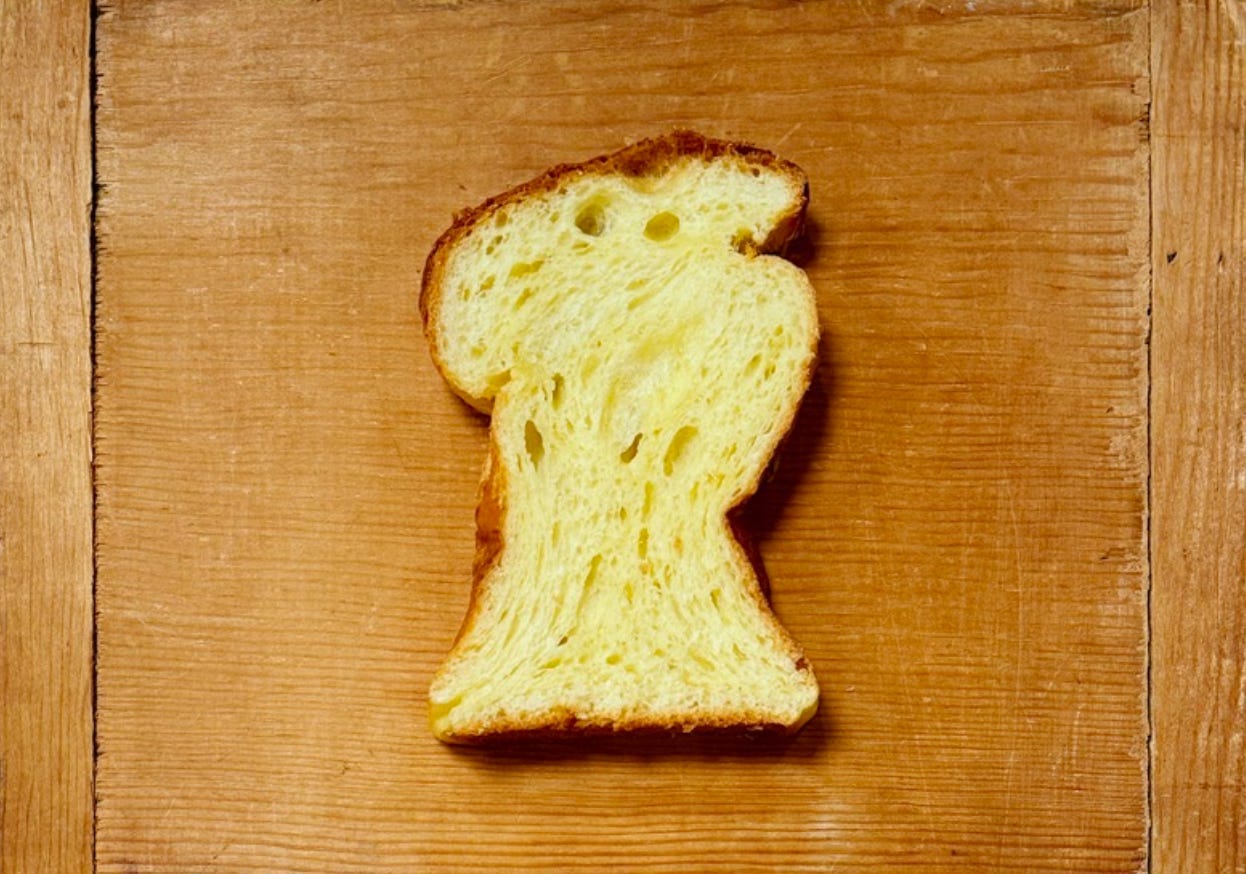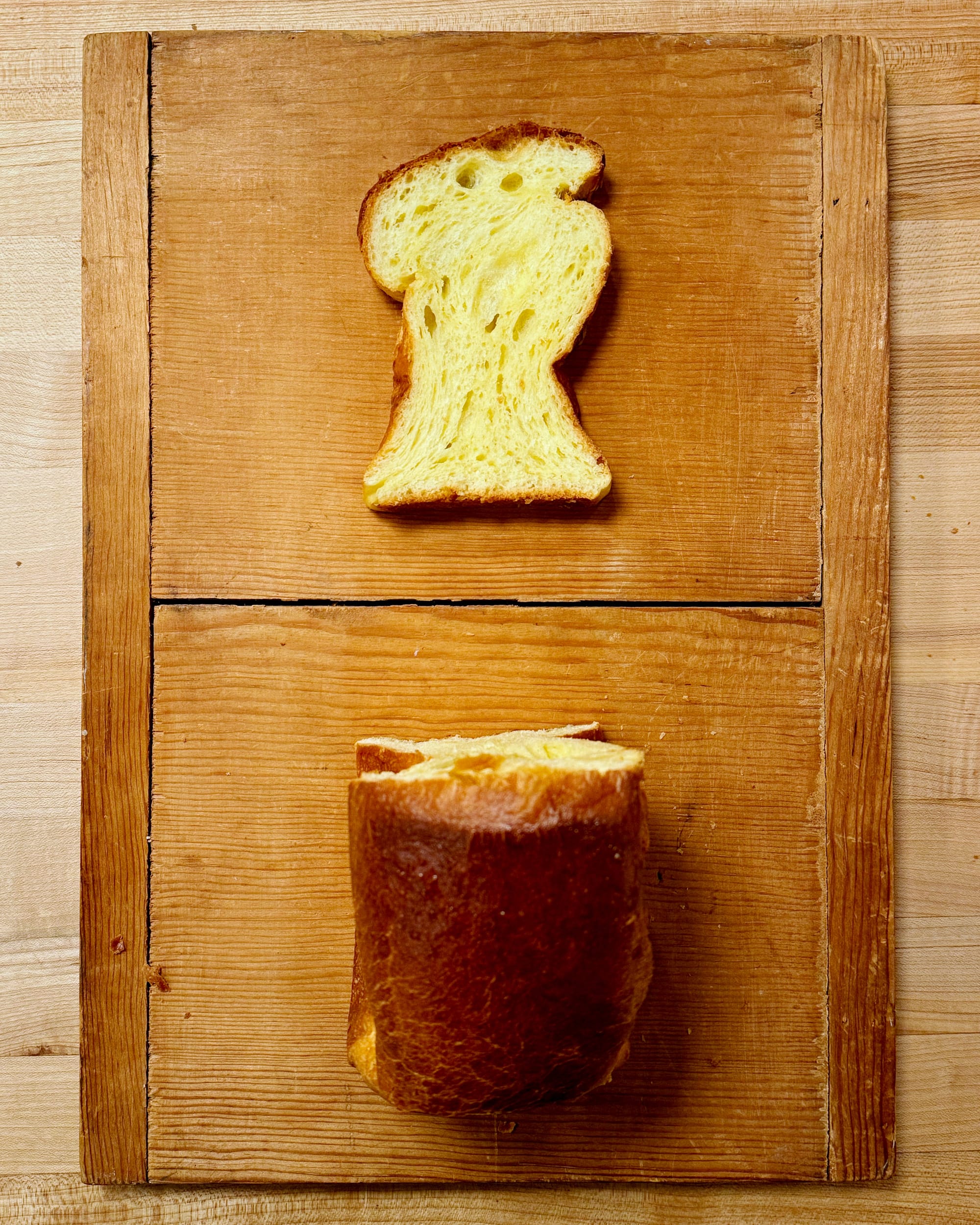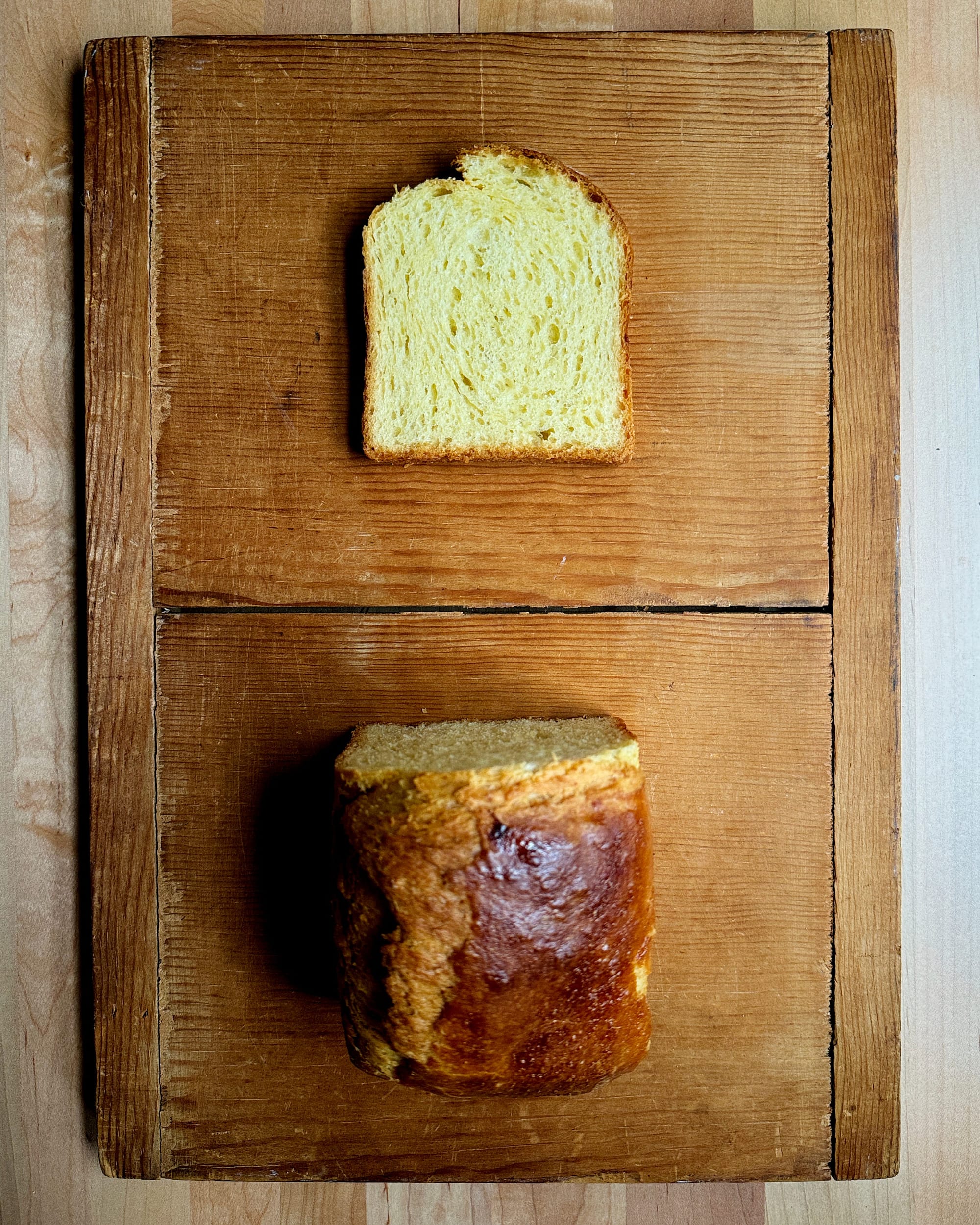The Other Side of the Keyhole
Or: Avoiding the dreaded suck-in

Table of Contents
Keyholing is the name given to the tendency of a just-baked soft bread to “suck in” as the gases within it condense as the loaf cools, leaving its slices with a silhouette like an old-fashioned keyhole. It is especially prone to happening in enriched breads, particularly those baked in pans. (It happens with buns and hearth loaves too sometimes, where the breads will have a shrunken shape, with a wrinkled skin.) The higher the amount of gluten-weakening fat in the bread, the more likely it is to happen; breads like brioche, containing 50% butter or more, are notoriously susceptible to keyholing. When I began working on the enriched bread formulas for Breaducation, it was happening with all of them to one degree or another, brioche especially.
For reasons I’ll go into in more detail in an upcoming post, my typical approach to enriched breads is rather different than most bakers. Normally, a baker will take pains to develop the dough fully in a mixer without any fat, to ensure the dough has sufficient structure before adding any gluten-weakening ingredients. Once the dough is strong, they will then add the fat—softened but still cool, in the case of butter—a little bit at a time until it is fully incorporated. It’s not hard to do, but it’s kind of a pain in the ass, at least relative to other bread-mixing strategies.
I’ve made brioche that way too, but early in my enriched-breads career, I developed a recipe for a no-knead version that had no mixing and in which the butter was added to the dough from the start, melted. It worked well, and ever since I have been skeptical that holding back the fat was all that essential. While I do develop my enriched breads these days, I always add the fat at the beginning of mixing, melted when it is butter. Here’s one of the early versions of the brioche formula for Breaducation, made exactly that way:

It’s not bad, right? It has an even, not particularly dense crumb, and it is plenty tall, despite having been made in an unorthodox, lazy-baker way. But I wasn’t happy with how much it keyholed; I can live with a little bowing-in of the sidewalls as long as the loaf is more-or-less square, but this was a little too wonky for me.
So I asked around to bakers for tips on how to avoid it. I got a lot of advice, some of it contradictory—develop the dough more, bake at a higher temperature, bake at a lower temperature, bake longer, remove the loaf from the pan near the end of baking to firm up the crust, etc. Some experiments yielded improvements (baking longer, especially), but none solved the problem entirely.
The conventional wisdom is that keyholing is caused by weak sidewall structure, and it is, at least in part. Breads baked in a pan see plenty of heat from the open top and on their undersides, which are exposed to the heat of the hearth. But their sides see the least heat, and the pan walls trap a lot of moisture close to the loaf. If not baked long enough, the sidewalls will remain soft and pale. Baking longer and/or outside of the pan near the end of baking can firm up the sidewalls and reduce keyholing, but it didn’t eliminate it entirely for me.
In the end, the solution—which I sorted out on my own—was a surprising one. Thinking that maybe my lazy approach to enriched breads was not sufficiently rigorous enough to work with brioche and its excess of butter, I took my formula and made it the “conventional” way. I held back the butter, developing the dough to full strength—far more than I usually do—then added the softened butter a pat at a time until the dough was smooth and supple. The dough felt beautiful, and I had high hopes my keyholing would vanish. This is what I got instead:

Now I will admit that the crumb on that brioche is damn sexy, but the keyholing is obviously way worse, and entirely unacceptable. Moreover, the loaf baked up far too tall, mushrooming out of even a roomy pan. As confusing as the result was, it seemed clear that developing the dough more made it more likely to happen, not less.
So for my next test, I went back to my usual approach, but developed the dough minimally—six minutes on low speed, after which the dough was uniform, but still shaggy and sticky. I don’t love working with sticky doughs, but since all of my enriched bread formulas get moved to the fridge to chill them down and firm them up before shaping, it’s not necessarily a dealbreaker. Still, I was skeptical this would give me anything other than a dense foam brick, and I baked it off with little confidence. Here’s what I got:

Again, I’ll admit that the crumb on that loaf isn’t half as sexy as the earlier one, but it’s certainly sexy enough, especially given that the loaf is square and true on three sides. It’s closer, but it is definitely not dense, and it was plenty light and tender. And the stature of the loaf was more appropriate, without any mushrooming.
So what gives? Why would undermixing make a loaf more structurally sound, not less? Here’s my current theory: The causes of keyholing are twofold—a weak external structure and a strong internal one. The reason the crumb on the traditionally-developed one is so open and the loaf so tall is because the gluten is strong enough to support large alveoli and allow the loaf to expand maximally while it is in the oven and hot. As long as the gases it contains are keeping those alveoli inflated like a hot air balloon, all is well. But away from the heat of the oven, the gases begin to condense, and the internal strength of the bread becomes a liability, one that even a well-firmed set of sidewalls can’t always overcome. By dialing back dough development, the loaf won’t be tempted to grow taller and more open than it has the structure to support once it’s no longer propped up by the force of expanding gases.
The thing is: you do compromise volume and crumb openness when you do this, as should be clear. But the crumb on the “undermixed” one is plenty open enough for me, and it is a compromise I’m willing to make to keep my pan loaves square. And you can easily make up for lost volume by simply increasing the amount of dough you put in the pan. (In my case, I didn’t need to, since the overmixed loaves were far too huge anyway.)
Now, full confession: One reason keyholing is a problem for my enriched breads is that they all contain a flour scald such as a tangzhong. I'll talk more about this next week, but since a flour scald leaves the finished bread softer and more moist than one without one, it’s even less able to hold itself up and open. So some of this is my own fault.
But keyholing is a potential problem with all enriched breads, and it’s something many bakers experience, flour scald or no. (In fact, this post was inspired by a conversation I had last week with Laila O’Boyle, who was having this very issue with her brioches.) If you find it happening to yours, it is worth considering whether you are overmixing your dough. (I’ll talk more about what my doughs look like at the end of mixing next week.)
Is keyholing something you’ve encountered, and if so, have you figured out your own ways to avoid it?
—Andrew
wordloaf Newsletter
Join the newsletter to receive the latest updates in your inbox.



